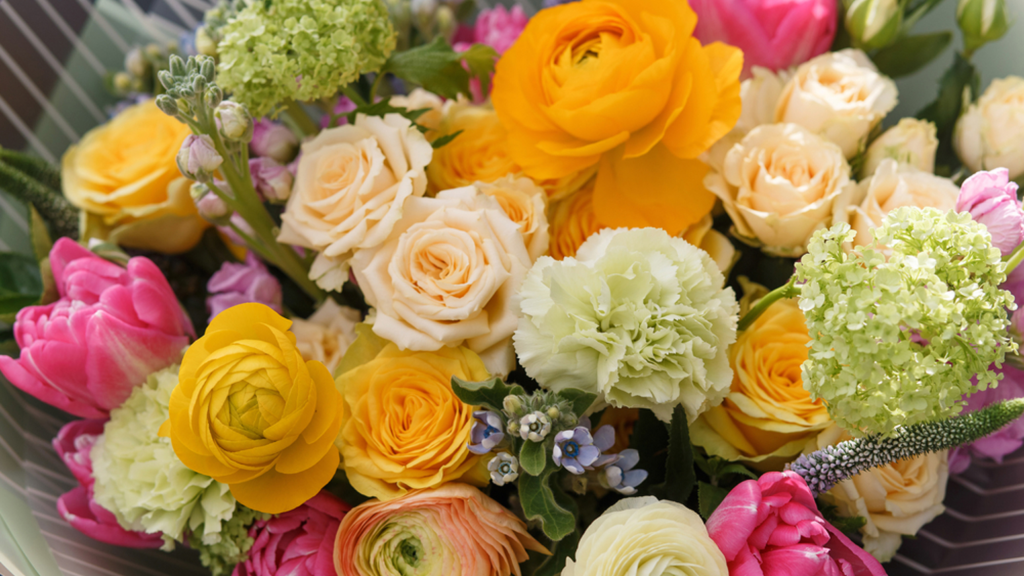Ever wondered why flowers bloom in so many colors?
Well, flowers are not just pretty to look at — they have some amazing things that most people don’t know about.
In this blog, you will learn some interesting facts about flowers that go beyond petals and perfume. From strange science to history and everyday uses, you will see flowers in a whole new way by the end.
So, let’s get into the world of flowers and see what makes them so special.
Facts Related to Flower Biology
Flowers are not just colorful parts of plants; they are full of surprises. From how they grow to how they survive, flowers show some pretty clever tricks.
Let’s look at how nature makes flowers truly one of a kind.
1. Some Flowers Close at Night
Flowers like tulips, poppies, and daisies close their petals when it gets dark. This daily habit is called nyctinasty.
It helps protect their pollen from cold air, moisture, and curious bugs. In the morning, they open again to welcome the sunlight.
2. The Smallest Flower is Tiny Like a Speck
The duckweed plant produces the tiniest flower in the world, only about 0.3 mm wide. It looks more like a dot than a blossom.
Even though it’s so small, it still counts as a true flowering plant and plays a big role in keeping ponds clean and healthy.
3. Sunflowers Turn Toward the Sun
Young sunflowers follow the sun’s path from east to west during the day, a phenomenon known as heliotropism.
It helps the plant absorb more sunlight to grow strong. Once the flower fully blooms, it usually faces east and stops turning.
4. Roses have Little Thorns Called Prickles
Those sharp points on rose stems may look like thorns, but they are called prickles.
They act like little guards, stopping animals from chewing on the stems. And for gardeners, they are a reminder to wear gloves.
5. Bamboo Blooms Once in a Lifetime
Most types of bamboo flower only once every 60 to 120 years. When they do, all plants of that species bloom at the same time, even across the world.
After flowering, the bamboo usually dies, but new shoots grow from the seeds it leaves behind.
6. Lotus Seeds Can Live for Centuries
Scientists once grew a lotus plant from a seed that was over 1,000 years old. That’s older than many ancient buildings!
These water-loving flowers can stay alive and dormant for a very long time, which is why they are seen as symbols of long life and rebirth.
7. The Largest Flower has No Stems or Leaves
Rafflesia arnoldii is known as the world’s biggest flower. It can grow over 3 feet wide and weigh up to 24 pounds.
This flower doesn’t have leaves, roots, or stems. It grows on vines and emits a strong, rotten smell to attract flies.
8. Flowers Can Hear Pollinators
Plants respond to buzzing sounds from nearby bees. Research shows that flowers quickly made their nectar sweeter after hearing the wings of bees.
Nature shows its complexity through plants that can sense sound waves without ears. The flowers can tell the difference between insect sounds and other noises like wind.
9. Venus Flytraps Also Bloom
While Venus flytraps are famous for catching bugs, they also grow small white flowers on tall stalks.
These flowers grow away from the traps, so bees and other pollinators don’t get caught while helping the plant reproduce.
10. Hydrangeas Can Change Color
Hydrangea flowers can switch from pink to blue depending on the soil they grow in. However, acidic soil produces blue flowers, while alkaline soil yields pink ones.
This neat trick happens because the plant absorbs aluminum from the ground, making hydrangeas a living soil test.
Facts Related to Pollination and Nature Helpers
Flowers can’t grow seeds on their own. They need some friendly help from the world around them.
Bees, birds, butterflies, and even bats work together with flowers to move pollen and make new plants.
Let’s know how nature helps.
11. Bees See Flowers in UV Light
Bees can see ultraviolet (UV) light, which humans can’t see with their eyes. Many flowers have special UV patterns on their petals.
These patterns act like glowing signs, guiding bees straight to the nectar. It’s like a hidden map only bees can read.
12. Some Flowers Smell Like Meat
The corpse flower has one of the worst smells in nature, and it smells like rotten meat.
This gross scent is not just for fun. It attracts flies and beetles, which typically feed on carrion, or the remains of dead animals. When they land on the flower, they spread its pollen.
13. Buttercups Reflect Light on Skin
Buttercup flowers have shiny yellow petals that reflect light like tiny mirrors.
If you hold one under your chin, the reflection might make your skin glow yellow. The flower’s shiny surface also helps bees find it more easily in sunlight.
14. Some Orchids Grow Underground
Not all flowers need the spotlight to bloom beautifully. The underground orchid of Australia hides its entire life cycle below the dirt.
These unique plants never see the sun, yet grow and make flowers in total darkness. Instead of getting their food from sunlight like most plants, they get it from friendly fungi and nearby plant roots.
15. Dandelions Help Early Bees
Dandelions are among the first flowers to bloom when spring begins.
They give bees one of their first meals after a long winter. Their bright yellow color makes them easy for bees to find in cool, early weather.
Facts Related to Flower Adaptations
Some flowers have special tricks to help them survive in tough places.
Others can fool animals, change their appearance, or wait a long time before blooming. These clever moves help them stay alive and spread their seeds.
16. Some Flowers Use Water as a Weapon
The squirting cucumber isn’t shy about how it spreads its seeds. When ripe, this plant builds up water pressure inside until it bursts open.
The seeds shoot out with a mix of juice, flying up to 20 feet from the parent plant. This smart method helps the plant spread its children far away, giving them plenty of room to grow.
17. Poinsettias aren’t Red Petals
Those bright red parts on poinsettias are not flower petals at all. They are colorful leaves called bracts.
The real flowers are small and yellow and sit right in the center. The red leaves help draw attention to the tiny flowers inside.
18. Chocolate Starts with a Flower
The cacao tree grows little white flowers right on its trunk and branches.
Once pollinated, these flowers grow into large pods filled with cocoa beans. These beans are dried, roasted, and turned into the chocolate you enjoy.
19. Orchids Can Be Very Tricky
Some orchids use clever tricks to get what they want. They look and smell like female insects to attract male ones.
When the confused insects land to mate, they accidentally pick up pollen and carry it to other flowers. It’s nature’s way of fooling bugs into helping out.
20. Some Flowers Grow in Ice
Certain flowers live in freezing parts of the world, like the Arctic and high mountain areas.
They bloom very quickly during short summer seasons. These flowers are built to survive cold winds and grow with very little sunlight.
Facts Related to Flowers You Can Eat & Enjoy
Flowers do more than brighten up gardens. Some end up on your plate, in your drink, or even help you feel better.
Whether they are part of your dinner or used in sweet scents, flowers have plenty of fun and helpful uses.
21. Broccoli is a Flower
When you bite a piece of broccoli, you are eating unopened flower buds.
If the plant is left to grow, those tight green buds bloom into small yellow flowers. It’s one of the healthiest flowers you can eat!
22. Vanilla Comes from An Orchid
Vanilla flavor comes from the long seed pods of a special orchid plant.
Each flower only blooms for a single day, and farmers have to hand-pollinate it to get the pod. That’s why real vanilla is rare and expensive.
23. Banana Plants have Huge Flowers
Banana plants grow large, purple-red buds that hang downward.
Inside the bud, rows of tiny flowers appear, and each one turns into a banana. After one big bunch, the plant’s main stem dies, but new shoots grow nearby.
24. Jasmine Helps People Relax
Jasmine flowers give off a soft, sweet scent that people find calming.
Some studies show that just smelling jasmine can improve sleep and reduce stress. That’s why jasmine is often used in tea, oils, and even pillows.
25. Some Flowers Can Be Eaten
Flowers like pansies, nasturtiums, and roses are not just pretty; they are edible too.
They are often used to decorate cakes, brighten up salads, or add a touch of flavor to drinks. Before eating them, just make sure they’re grown without harmful chemicals.
Facts Related to History, Culture, & Science
Flowers have played an important role in human life for thousands of years.
They have shaped traditions, inspired celebrations, helped create medicines, and even pushed scientists to learn more about the world around us.
Let’s look at how flowers have left their mark on history and science.
26. Tulips Once Cost More Than Gold
In the 1600s, the Netherlands was obsessed with tulips. Rare and colorful bulbs became so valuable that some cost more than a house.
This period, known as Tulip Mania, is one of the earliest examples of a financial bubble in history. It shows just how much people loved flowers, even to the point of gambling their savings.
27. Chrysanthemums are Celebrated in Japan
In Japan, chrysanthemums are more than just garden flowers; they are symbols of happiness, strength, and long life.
There is even a national festival called the Festival of Happiness held every year to honor them. These flowers are also on the royal seal of Japan.
28. Passionflowers have Religious Symbolism
When Spanish missionaries first saw the passionflower, they noticed something special in its shape.
The flower parts seemed to tell a story; the petals stood for disciples, and the ring of filaments reminded them of the crown of thorns.
The flower’s styles were seen as nails, while the leaves looked like the hands of those who sent Jesus to death.
29. Flowers Gave Us Important Medicines
Many medicines come from chemicals found in flowers and other plants.
For example, foxglove is used to treat heart problems, and meadowsweet was the plant behind the invention of aspirin. Flowers continue to help doctors and scientists fight illness.
30. Botany is the Study of Flowers
Botany is the science of studying plants, including flowers. Botanists examine how plants grow, survive, and interact with their surroundings.
Some experts, called floriculturists, focus just on flowers and how to grow them for gardens, bouquets, and food.
31. Bees Visit Millions of Flowers for Honey
To make just one pound of honey, bees must visit about 2 million flowers. They fly from bloom to bloom, collecting nectar and spreading pollen as they go.
It takes bees approximately 55,000 miles of flying to create that sweet, golden treat, which shows how hard these tiny workers really work.
So the next time you walk by a flower, take a moment to wonder what secret it might be hiding. Which flower fact surprised you the most? Share your thoughts in the comments below!















